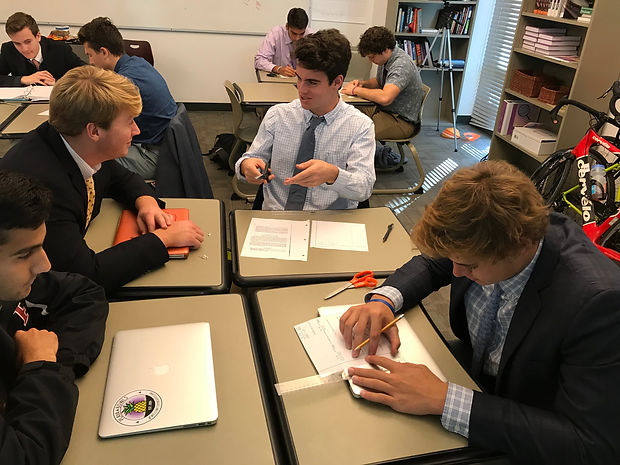
Calculus
This was another fantastic course to teach in my introductory year at The Haverford School because it gave me insight into the culminating experiences of our Form VI senior students at the end of their tenure as THS students. I taught the course with former Math Dept Chair Susan Mitchell, and she, along with current Math Chair Justin Gaudreau, had done excellent work before my arrival revamping the curriculum to make it a more relevant and rigorous course for our students. I immediately became aware of the pressures the senior students faced to get the good grades and complete the applications to their preferred colleges, many of which now require a year of Calculus as a prerequisite for admission. As the year went on and I reflected on the teaching and learning in my classroom, I began to identify two objectives that I wanted to accomplish in my second year with the course.
The first was to address the sequencing of the topics. My predecessors with the course did well to reinstate some of the more challenging and rewarding topics to the curriculum, but I wanted to adjust the course to take a "Late Transcendentals" approach, rather than an "Early Transcendentals" approach. In short, this means cover both branches of Calculus, Differential and Integral, culminating a proof of the Fundamental Theorem of Calculus by the time of December exams. My reasoning had both pedagogical and practical aims. Pedagogically, The Fundamental Theorem of Calculus is what makes the course magical theoretically and is what links the entire course together. Previously, this essential topic was taught in March, and I realized in my first year, the students had become fatigued and were beginning to lose the intellectual energy present earlier in the course and so did not treat the topic with the requisite focus. In honest reflection, I can remember as a student myself under the "Early" approach, that the Fundamental Theorem just seemed like another thing in the curriculum, rather than they lynchpin topic it is. So in moving the topic earlier in the year and thus the introduction to Integral Calculus as well, it ensured that the students really had the opportunity to appreciate its significance for the entire subject of Calculus. In order to then fit both an introduction to Differential and Integral Calculus all by the December exam, we had to postpone the opportunity to delve into the more complex applications of Differential Calculus until February. But I anticipated that this would be no bad thing, but rather, quite beneficial to the students' learning. These complex applications are technically tedious and require a tremendous amount of mastery over Algebra skills, something that I found my seniors struggled with. In my first year teaching the course, I found that for a number of students, many were on the verge of intellectually checking out by the end of November because they felt alienated from the course by the level of prerequisite Algebra skills needed to succeed. However, by focusing on the concepts of both branches of Calculus in the fall and really emphasizing their interconnectedness with the Fundamental Theorem in December, the students remained highly engaged and nature of my teaching focused on higher order thinking rather than review of rote skills. When we did reach the complex applications of Calculus later in the winter, we were able to take a spiraling approach thereby continuously giving the students opportunity to review all the concepts they had learned in the form of new applications, as well as to see how the "inversing" nature of the two branches played out in real world scenarios. The practical consideration is that by focusing on the students' strengths in the fall, rather than harboring on their weaknesses in algebra, I was able to keep them motivated in the class longer and they certainly saw the effect in their fall grades, which were important for their college applications. They reported positive feedback on approach and I would certainly consider sticking with it in future classes.
The second objective was to make the course more project-based. The idea was to collect real world data from the website Gapminder which tracks the correlation of social, political and environmental phenomenal based around the UN Sustainability Goals. Students would then model the data with an appropriate function and use the tools of Calculus as we learned them to analyze the data and derive real insights into the phenomena they were interested in. The project didn't reach a successful conclusion for a myriad of reasons. Structurally, my method for assessing their work didn't quite reach the level of coherence that I needed and the scheduling of their deadlines became problematic as the year progressed. Maybe as a consequence, I never really felt like I got the student buy-in I needed to undergo such a major project and after some really good learning moments and a number of frustrating dead-ends, I decided to put the project on ice for the year. If given the opportunity to teach the class in the future, I would certainly want to analyze the feasibility of the project again.
All in all, I believe that the Standard Level Calculus course presents a unique opportunity for creative thinking about teaching and Project-Based Learning because it is the main mathematical tool by which real analysis is done in the Natural and Social Sciences. The meaningful real-world applications are right there to be addressed, potentially creative interdisciplinary ways. We just have to structure the course and our assessment methods to get the best out of the opportunity. Also, as Justin Gaudreau recently pointed out, nearly two thirds of our students take Calculus. In that number presents a real opportunity to make the course something of a thematic cornerstone for our students entire Haverford Math Department experience and their holistic experience as THS students overall.
